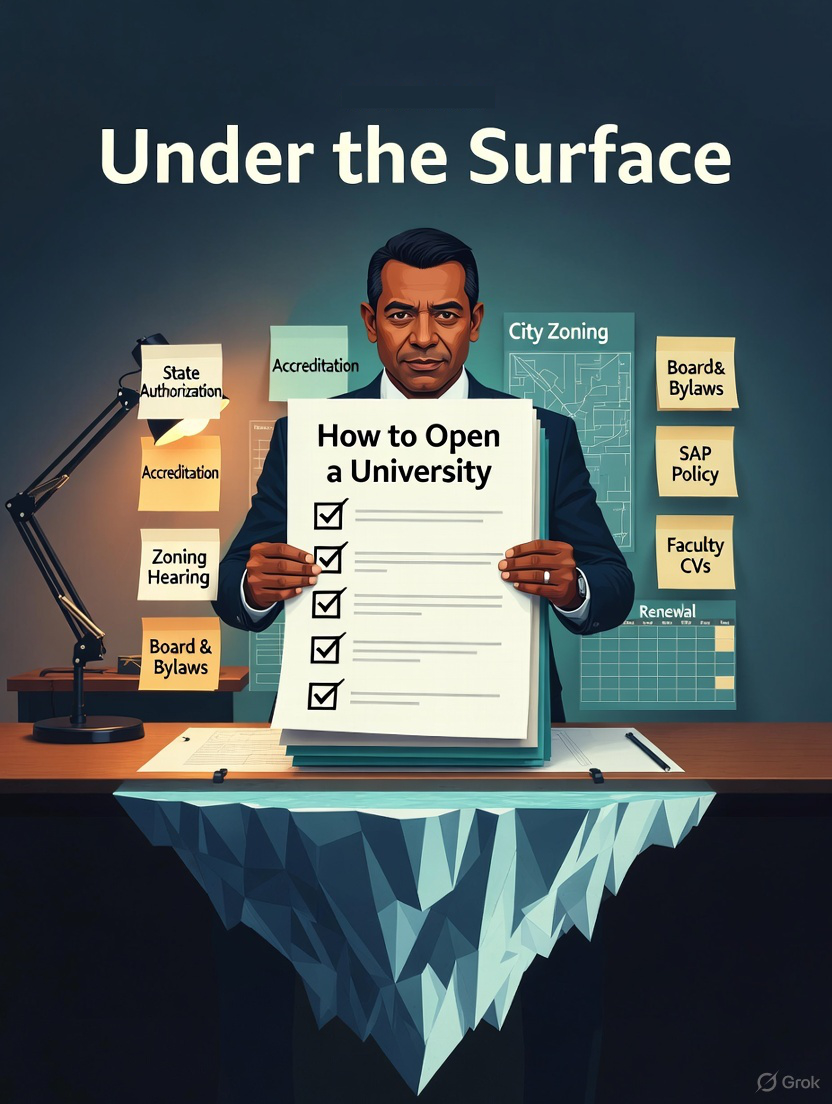Accreditation Aftershock: Navigating New Rules and Alternative Accreditors in 2026
“I just got the CIE provisional license—now what?”

This involves helping our clients understand all the legal and financial requirements around university establishment, as well as providing marketing and branding advice to ensure their university or college stands out from other educational institutions.
Our competitors can only offer a limited service, either licensing or accreditation, as most don't have the skills or team required to provide a turnkey service. This is why EEC stands out from the crowd – we can offer our clients everything they need to get their university off the ground easily and efficiently.
At EEC we're looking at building a long-term relationship with our clients, where launching a university is only the first step.
We are confident that no other company can match our team of experts and their specialized knowledge.
A field guide for new founders, presidents, and startup teams opening a university in Florida
You did it. You walked out of the Commission for Independent Education (CIE) process with a Provisional License in your hand. If you’re like most founders I’ve worked with, you’re feeling a mix of relief, adrenaline, and just a touch of “what did I just sign up for?” That feeling is normal. Getting a provisional license is the moment your idea moves from sketchbook to reality—you are now operating a university.
This article is my plain‑English, from‑the‑heart roadmap for what to do next. I’ll demystify the rules, translate jargon, give you real‑world checklists, and share the early‑days playbook we use with startup campuses. I’ll also weave in the compliance and operations items that the Commission and local authorities actually look for—the same details we’ve used to launch teams through their first 30 days and onto annual licensure. Where it helps, I’ll point to examples and ready‑made checklists from launch plans and approval documents so you can see what “good” looks like in the wild.
Part 1: What a CIE Provisional License really means (and what it does not mean)
In one sentence: a CIE provisional license lets you operate while you prove that you can meet every standard for an Annual License; it does not let you award degrees yet.
The Commission’s standard provisional‑licensure letter spells out your guardrails in unmistakable terms: you may advertise, recruit students, accept tuition and fees, and hold classes. But you may not award a degree or any credential that takes one year or more to earn during provisional status. Also, you can only promote and offer the programs that appear on your “Approved Data” sheet—no exceptions. The Commission can extend provisional status under Rule 6E‑2.002(1)(d) in some circumstances, but your aim is to clear the bar for an Annual License as soon as you’re ready.
Your actual license certificate confirms your campus location and effective date—treat it like a birth certificate for your university. (Example: a provisional license certificate shows the school name, campus address, start date, and license number.)
What’s on the “Approved Data” sheet? Think of it as your menu: campus details, license status, Annual Review Date, your Commission program specialist, institutional contact, and most importantly the list of programs and degree levels you are approved to teach and advertise. If it’s not on this list, you cannot market it. Example sheets show entries like BA Business Administration (120 credits), MS Computer Science (36 credits), PhD Education Leadership (60 credits), and so on.
From‑the‑heart advice: In your first town‑hall with staff, repeat this simple line: “We can teach. We can recruit. We can collect tuition. We cannot award degrees yet, and we cannot promote anything not on our Approved Data sheet.” That one refrain prevents 80% of early‑stage compliance headaches.
Part 2: The first 48 hours—set the rails before you hit the gas
You’re probably already running ads and onboarding students. Great. Before momentum turns into messiness, do these four things:
- Freeze the program set everywhere. Update the website, catalog, social posts, PPC ads, and any third‑party listings so they match the Approved Data exactly. Remove “coming soon” majors, concentrations, or campuses. Archive screenshots of every ad and landing page in your compliance folder. (Our 30‑day launch checklists call this a Day‑0 non‑negotiable.)
- Publish the Provisional‑status disclosure in plain English. Add it to the catalog, enrollment agreement, website FAQ, and orientation slides. Example language: “The university holds a Provisional License from Florida’s CIE. We may advertise, recruit, accept tuition, and teach classes. The university may not award degrees until an Annual License is granted.”
- Stand up three short weekly huddles:
- Licensing/Compliance Stand‑up (catalog, enrollment forms, refund policy, ads, financials, personnel files).
- Academic Council (CAO, Registrar, Student Services, IT/LMS, program chairs) to monitor teaching quality and student progress.
- Ops Huddle (Facilities, HR, Bursar, Marketing) to manage postings, staffing, and help‑desk SLAs. These rhythms come straight from day‑1 launch playbooks.
- Licensing/Compliance Stand‑up (catalog, enrollment forms, refund policy, ads, financials, personnel files).
- Do a postings walk‑through and snap photos. Inspect reception and staff areas to confirm:
- Local Business Tax Receipt (LBT) is “exhibited conspicuously”—the county literally warns of a penalty if it isn’t.
- Certificate of Use/Occupancy is available for inspection.
- Labor‑law posters are visible to employees.
These three were called out as required postings and best practice for inspections in our startup university plans.
- Local Business Tax Receipt (LBT) is “exhibited conspicuously”—the county literally warns of a penalty if it isn’t.
Part 3: The first month—your 30‑day operating plan (with numbers that actually work)
A well‑run first month is the difference between a calm sprint and a year of cleanup. The launch roadmaps below are stitched together from battle‑tested 30‑day plans and readiness decks used for inaugural cohorts of ~70 students. You can copy them.
The outcomes to hit by Day 30
- Seamless start: orientation completion ≥95% by Day 3; first login within 24–48 hours for ≥95%.
- Engagement: weekly attendance ≥90%; live session attendance ≥85%.
- Quality: 100% of courses QA‑passed before Day 1; feedback within 5 days on graded work; gradebook configured in every section.
- Student support: early alerts closed within 48–72 hours.
- Compliance hygiene: disclosures live; enrollment agreements countersigned; refunds and records auditable.
These targets are pulled directly from the launch KPIs and SLAs we rely on during the first month.
Week‑by‑week
Prep (Days −7 to 0)
- Course shells QA (outcomes ↔ assessments mapped, rubrics attached, accessibility checks complete); welcome videos posted.
- Orientation live (90–120 minutes); SSO/MFA tested; automated “no login/no submission” nudges ready.
- Publish refund timelines and complaint process in catalog/website; ensure enrollment agreements reflect delivery modality.
Week 1: Start strong
- Run a 60‑minute live kickoff in two time blocks, record, and post.
- Micro‑assignment due by Day 3–4 in every course to establish LDA (last date of academic activity).
- Advisors contact any no‑login/no‑submission students and log cases.
Week 2: Stabilize
- QA spot‑checks on 25% of sections (accessibility, feedback quality, timeliness).
- Skills Clinics (writing, quantitative reasoning, library research).
- Mini‑audit: attendance exports, gradebook integrity, comms logs, refund triggers.
Week 3: Deepen support
- Mid‑module assessments with integrity measures (plagiarism detection, proctoring where appropriate).
- Faculty development huddle to share engagement insights; accessibility checkpoint to confirm accommodations are working.
Week 4: Transition & review
- Gradebook health check; on‑time feedback ≥95% within five days.
- Student satisfaction pulse (target ≥4.2/5).
- Day‑30 Executive Review: go/no‑go on next‑term modality, resource adjustments, policy updates.
ELI5: What is LDA and why do we care?
LDA (Last Date of Attendance/Academic Activity) is the last day a student did something academic you can document (submitted work, took a quiz, interacted with a professor about coursework). You use LDA for refunds, withdrawals, and financial records. A micro‑assignment due by Day 3–4 creates a clean LDA for everyone.
Part 4: Guardrails most teams miss (and how to stay out of trouble)
- Don’t award degrees (or 1‑year credentials) during provisional. Yes, students complete courses; no, you cannot confer degrees yet. Your letter says this explicitly. Keep your registrar templates and any student letters crystal clear to avoid implying degree awards.
- Only market programs on your Approved Data. Your sheet is your truth. If you want to add a concentration or new degree, that’s a post‑Annual License conversation with the Commission.
- Post what must be posted. The Local Business Tax Receipt must be displayed “conspicuously” at your place of business—county staff can (and do) drop by to check. Keep your Certificate of Use handy and your labor‑law posters visible to employees.
- Operate within your zoning. If your campus is in an Industrial Business Park (IBP) district, you’re fine because IBP permits “vocational, technical, business, trade or industrial schools and similar uses.” If you expand, add signage, or change the use, consult city zoning first.
- Be thoughtful about where students reside. Many launch plans choose Florida‑only enrollment during the provisional year to keep state‑authorization complexity low. If your internal readiness plan or counsel says no out‑of‑state enrollment during provisional, follow it. (Always confirm with your counsel/Commission specialist.)
Part 5: The people side—who owns what in month one
A startup university is a human project. Clear role definitions prevent crossed wires. Here’s a simple map you can adopt (or adapt), built from the “Key Responsibilities for Startup University Leadership Roles” document.
- Chief Academic Officer (Provost): academic strategy, program launch, assessment plan, faculty recruitment, technology‑enabled instruction, and student success from an academic lens. Owns catalog and academic policy quality, as well as evidence for accreditation and CIE.
- Registrar: student‑records infrastructure (SIS), registration, transcripts, calendars, FERPA compliance, and reporting. In many startups, the registrar doubles as a compliance point person.
- Director of Student Services: orientation, advising, early‑alert, ADA/504 accommodations, tutoring, career services, student life—the whole wraparound experience.
- Admissions Director: recruitment strategy, funnel management, CRM discipline, ethical admissions, truth‑in‑advertising, and clean handoffs to advising.
- Accreditation Liaison Officer (ALO): coordinates state licensure and regional accreditation threads so they tell the same story and stay on time.
Part 6: Your campus paperwork—what needs to live on the wall and in the binder
On the wall (front desk or employee area):
- Local Business Tax Receipt (LBT)—display conspicuously; the county receipt literally warns of a penalty if you don’t.
- Certificate of Use/Occupancy—for your specific suite and business type (e.g., “Administrative Offices for Post‑Secondary Education”).
- Labor‑law posters—federal and Florida notices where employees can easily see them.
In the binder (digital is fine):
- Provisional License + letter + Approved Data.
- Catalog, Enrollment Agreement, Refund Policy + their Commission checklists.
- Faculty Listing (Form 401) + faculty credential files; Personnel forms (Form 402) for administrators.
- Financials required for your license category (compiled, reviewed, or audited), Finances Checklist, and Selected Financial Data (Form 604).
- Advertisements & Other Publications (one copy of each), Zoning/COU/LBT evidence, organizational chart, and any admissions training certificates.
Part 7: Corporate and local housekeeping (boring… until it isn’t)
Annual licensure depends on your institution being a healthy business as well as a healthy academic community. The Commission will expect clean corporate status and local compliance. Here’s your short list:
- SunBiz Annual Report (Division of Corporations) every year Jan 1–May 1 to keep your entity active; there’s a well‑known $400 late fee if you miss it. Your Articles of Incorporation letter and certified copy will list your document number and remind you to file.
- Registered Agent & office addresses must stay current with the state. Your Articles and organizational minutes show your initial registered agent and principal office—update if you move operations.
- Board governance lives in your Bylaws and Minutes of Organization (which also record your officers and often your tax year—many startups adopt 12/31). Keep your minute book current.
- Fictitious name (“doing business as”) entries should be current and active, with the registration number and registration date on file. (Copy the certificate to your compliance binder.)
- Local Business Tax Receipt shows the account number, classification (e.g., School – Business/Vocational), and the valid‑until date—renew on time and keep it posted.
- Zoning: If you’re in Jacksonville’s IBP district, universities are generally fine because “vocational, technical, business, trade or industrial schools and similar uses” are permitted. File this reference in your binder for inspections and landlord conversations.
Why include corporate items in a “Now what?” post?
Because Annual Licensure can be delayed by something as unglamorous as a lapsed fictitious name or a missing LBT. Licensure is holistic—operations, academics, and business status all matter.
Part 8: The path to your Annual License—timeline, visit, and evidence
Your internal clock: submit a complete Annual License application ≥120 days before the provisional anniversary. In practice, we start 150 days out internally so nothing slips. The application packet is not mysterious; it’s a carefully curated set of artifacts you already use to run the university.
What’s in the packet?
- Catalog meeting Rule 6E‑2.004(11) + Catalog Checklist.
- Enrollment Agreement + Enrollment Agreement Checklist and Refund Policy Checklist.
- Program Outlines for each licensed program (must match Approved Data).
- Instructional & Administrative Personnel (Form 402) for new administrators; Faculty Listing (Form 401).
- Financials at the level your path requires (compiled, reviewed, or audited), Finances Checklist, Form 604.
- Advertisements and Other Publications (one copy each).
- Zoning/Occupational compliance evidence (Certificate of Use, LBT), organizational chart, and admissions‑training proof (e.g., FAPSC CM‑201).
- Fee Transmittals (Form 208) and, if applicable, Student Protection Fund transmittal (Form 206).
Site visit: Before the Commission grants initial annual licensure, expect a satisfactory on‑site visit by CIE staff (or provide an acceptable accreditor visit report). Build a one‑page “tour script”: admissions and catalog evidence, faculty files, LMS access, library resources, complaint log, and refund calculations.
Annual Review Date & data: Your Approved Data often lists an Annual Review Date. Use it to anchor your institutional data survey cadence—enrollment, withdrawals, graduates, placement %, updated catalog and agreements, financial reports. Build one tidy workbook and keep it current.
ELI5: What is the Student Protection Fund?
It’s a state‑managed safety net funded by participating institutions to help protect students if a school closes. For licensure/renewal, you may owe an assessment based on your first‑year enrollment; it’s included with your Annual License fee packet.
Part 9: Academics that scale—your quality system in simple building blocks
You don’t need a 300‑page handbook to open term one well. You need six building blocks:
- Clear outcomes for every program and course.
- Assessments that actually measure those outcomes (publish rubrics).
- Consistent syllabi with attendance, grading, integrity, and accommodations statements.
- Active gradebooks with feedback within five days (students learn from what you mark).
- Library and learning resources (and a 5‑minute “how to use the library” video).
- A simple assessment map—which outcomes each course supports, and where you’ll collect evidence every term.
That’s exactly what the Academic Delivery & Quality workstream in our launch checklists drives to “done” before Day 1.
Accessibility note: Closed captions, alt text for images, and rapid turn‑around on ADA/504 accommodations (often ≤3 business days) are not just legal—they are a brand promise. Put accommodation request links in orientation and every syllabus.
Part 10: Student success at 70‑student scale—what to watch and why
With a first cohort around 70 students, your goal is early momentum. The numbers we track daily/weekly aren’t random—they are leading indicators that prevent drops and withdrawals. Build a simple dashboard that includes:
- Orientation completion (target ≥95% by Day 3).
- First login (≥95% within 24–48 hours).
- Weekly attendance (≥90%).
- Early alerts (solve within 48–72 hours).
- Help‑desk SLAs: first response <1 hour at peak times; resolution <8 hours.
- Course‑QA pass rate: 100% pre‑launch; weekly re‑checks.
These thresholds come straight from month‑one playbooks and readiness decks.
Pro tip: Publish a student‑communications calendar. Pre‑schedule the “No login Day 2,” “No submission Day 4,” and “Week‑1 wrap” nudges with short, friendly scripts. Students feel cared for when the university is consistent.
Part 11: Facilities & safety—quiet strengths that inspectors notice
- Certificate of Use (COU): Keep the original (or a high‑quality copy) ready. If your COU lists your business type as “Administrative Offices for Post‑Secondary Education” at a specific suite, make sure your signage and actual use match the paperwork.
- Zoning (IBP District example): If you expand space, plan retail elements, or add signage, check IBP limits and exceptions first. The code is clear that schools and similar uses are permitted, but retail or outside storage have separate rules.
- Postings: Snap photos of your LBT on the wall—the county receipt warns about penalties if it isn’t displayed. Keep federal/Florida labor posters updated (your HR vendor can package these).
Part 12: Marketing within the rails—how to grow without tripping the wire
- One source of truth: The Approved Data list controls what you can advertise. Build your site navigation around those degrees (no “coming soon” pages).
- Proof archive: Keep one copy (PDF or screenshots) of every ad, landing page, and brochure in your binder. It’s an official exhibit in the Annual License packet.
- Admissions training: If you use recruiters or a small admissions team, plan for FAPSC CM‑201 (or equivalent) training and save the certificates.
Part 13: Real‑world example—locking operations to what’s actually licensed
Let’s say your Approved Data lists the following programs: BA and BS (120 credits), MS (36 credits), and doctoral programs (60 credits) in Business Administration, Computer Science, and Education Leadership. That is the universe of what you can advertise and teach while provisional. Tie your catalog, website menus, landing pages, and enrollment agreements only to those degrees, and remove any course sequences for unlisted concentrations until you have Annual Licensure and Commission approval for changes. Use your Annual Review Date as your internal deadline for the institutional‑data workbook (enrollment, withdrawals, graduates, placement %, updated documents).
On the facility side, if your Certificate of Use says “Administrative Offices for Post‑Secondary Education” at Suite X, keep activities consistent with that use category; any shift to public‑facing classrooms or student‑services build‑outs may require revisiting zoning or permits. IBP‑zoned sites are friendly to schools and similar uses, but read the exceptions for retail and outside storage.
Finally, post your LBT where visitors can see it (the county literally prints the penalty warning on the receipt). Take a photo and drop it in your binder—you’ll thank yourself during inspections and renewals.
Part 14: The soul of your startup—saying the right thing to students
Students will ask the big question: “Will I get my degree?” Here’s the simple, honest script:
“We’re operating under Florida’s Provisional License. That means we can recruit, teach, and support you fully right now. The last step—awarding degrees—happens once the state grants our Annual License. We’re on track and we’ll be transparent with you every step of the way.”
Publish that sentiment in your catalog, FAQ, orientation, and advising scripts. You’re not just opening a university—you’re building trust.
Part 15: Frequently asked founder questions
“Can I add a new program for next term?”
Not during provisional licensure. You may only advertise/offer what’s on your Approved Data. New programs are a post‑Annual License process.
“Can I confer certificates under a year?”
Only if the Commission specifically approved such short‑term credentials and they appear on your Approved Data. Otherwise, no.
“Do I have to frame the CIE license on the wall?”
Florida doesn’t require framing the CIE license, but your Local Business Tax Receipt must be visibly displayed, and the COU and labor posters should be accessible/visible.
“What happens if I miss SunBiz filings?”
You risk late fees and, worse, administrative dissolution. File your Annual Report every year by May 1. Keep your registered agent and office addresses current.
“When should I hire an accreditation consultant?”
If you plan regional accreditation (e.g., SACSCOC), bring in an accreditation consultant early—ideally before you finalize your first full catalog—so your policies, assessment, and faculty qualifications align with both CIE and accreditor expectations from Day 1.
Part 16: A one‑page checklist you can share today
- Programs & marketing: everything matches Approved Data; unapproved items removed.
- Disclosures: provisional‑status statement published in catalog, website, enrollment agreement, orientation.
- Postings: LBT on the wall; COU accessible; labor posters up.
- 30‑day targets: orientation ≥95% by Day 3; 1st login ≥95% by Day 2; weekly attendance ≥90%; early‑alert resolution ≤72h; course QA 100% pre‑launch.
- Annual License clock: internal D‑150 prep; D‑120 submission; site‑visit playbook ready.
- Corporate hygiene: SunBiz active; RA current; fictitious name active; LBT renewed on time.
Closing Thoughts
Provisional licensure is not a waiting room. It’s a working season. You’ll teach, serve students, and build the muscle you need for Annual Licensure. Keep your promises small and your execution excellent. Keep your ads honest, your catalog current, your gradebooks timely, and your postings visible. When the Commission comes to visit, you won’t be scrambling—you’ll be showing them the university you’ve already become.
If you need a partner to stand up the artifacts, pressure‑test your site‑visit playbook, or simply reality‑check your how much does it cost to open a university plan, find good counsel—or a seasoned accreditation consultant—to walk the road with you. But don’t lose sight of the heart of the work: real students, real learning, and a university you’re proud to put your name on.
You’ve already taken the hardest step. The rest is consistent, honest work—supported by checklists, clear roles, and a culture that cares about students. That’s how you move from Provisional to Annual, and from opening a university to sustaining one that changes lives.
For personalized guidance on managing your institution after you obtain a CIE provisional license, contact Expert Education Consultants (EEC) at +19252089037 or email sandra@experteduconsult.com.











